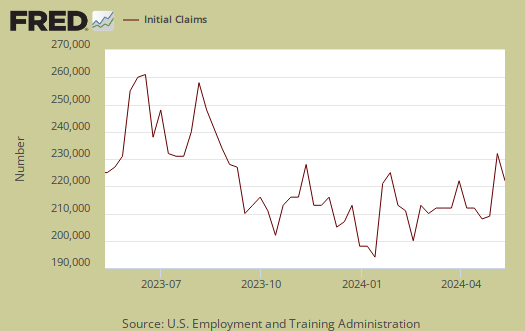The DOL reported people filing for initial unemployment insurance benefits in the week ending on July 13th, 2013 was 320,000, a 15,000 decrease from the previous week of 335,000. This is the second time in three weeks initial claims has hit pre-recession levels and the last time levels were this low is October 2007.

The more important statistic is the four week moving average on initial unemployment claims. The four week moving average decreased 4,000 to 336,000. In the below graph we can the four week moving average is now at pre-recession November 2007 levels. If anyone recalls, even before the Great Recession the job market was not so hot, yet this is finally, a positive sign, going on five years and eight months. The four week moving average is graphed below from January, 2007.

Below is the mathematical log of initial weekly unemployment claims. A log helps remove some statistical noise, it's kind of an averaging and gives a better sense of a pattern. As we can see, we have a step rise during the height of the recession, but then a leveling, then a very slow decline, or fat tail. That fat tail has taken over six years to return to early recession levels, so the time it has taken to drop might still be a concern. There are a lot of people out there who are not counted in labor force statistics who need a job.

As much as people wish it so, most government data is not complete and not real time. We have repeatedly warned, ad nauseum, do not bank on the initial claims number reported in the press release for that week. Initial claims for unemployment benefits is a weekly statistic and that implies a very short time window for data collection, it is always revised the next week, almost always upward. One can have unusual events which throw off the seasonal adjustment algorithm. One can have missed timing of events that can also throw a monkey wrench in one week's worth of data. As we pointed out in our weirdness in initial unemployment claims article, states might not report their quarterly adjustments for emergency unemployment benefits and we had the infamous fiscal cliff push past the final hour, which included extending those unemployment benefits for the long term unemployed.
Continuing unemployment claims for the previous week was unchanged by percentages and there are still large numbers of long term unemployed. The below continuing claims figure doesn't include those receiving extended and emergency unemployment benefits.
The advance seasonally adjusted insured unemployment rate was 2.3 percent for the week ending August 3, unchanged from the prior week's unrevised rate. The advance number for seasonally adjusted insured unemployment during the week ending August 3 was 2,969,000, a decrease of 54,000 from the preceding week's revised level of 3,023,000. The 4-week moving average was 2,986,500, a decrease of 38,500 from the preceding week's revised average of 3,025,000.
In the week ending July 27th the not seasonally adjusted, the official number of people obtaining some sort of unemployment insurance benefit was 4,586,860 with 1,552,910 people receiving 2008 EUC, which was extended to January 2014 in the 11th fiscal cliff hour. There were 11.5 million official unemployed in July. The number of unemployed has remained almost static.

Recent comments